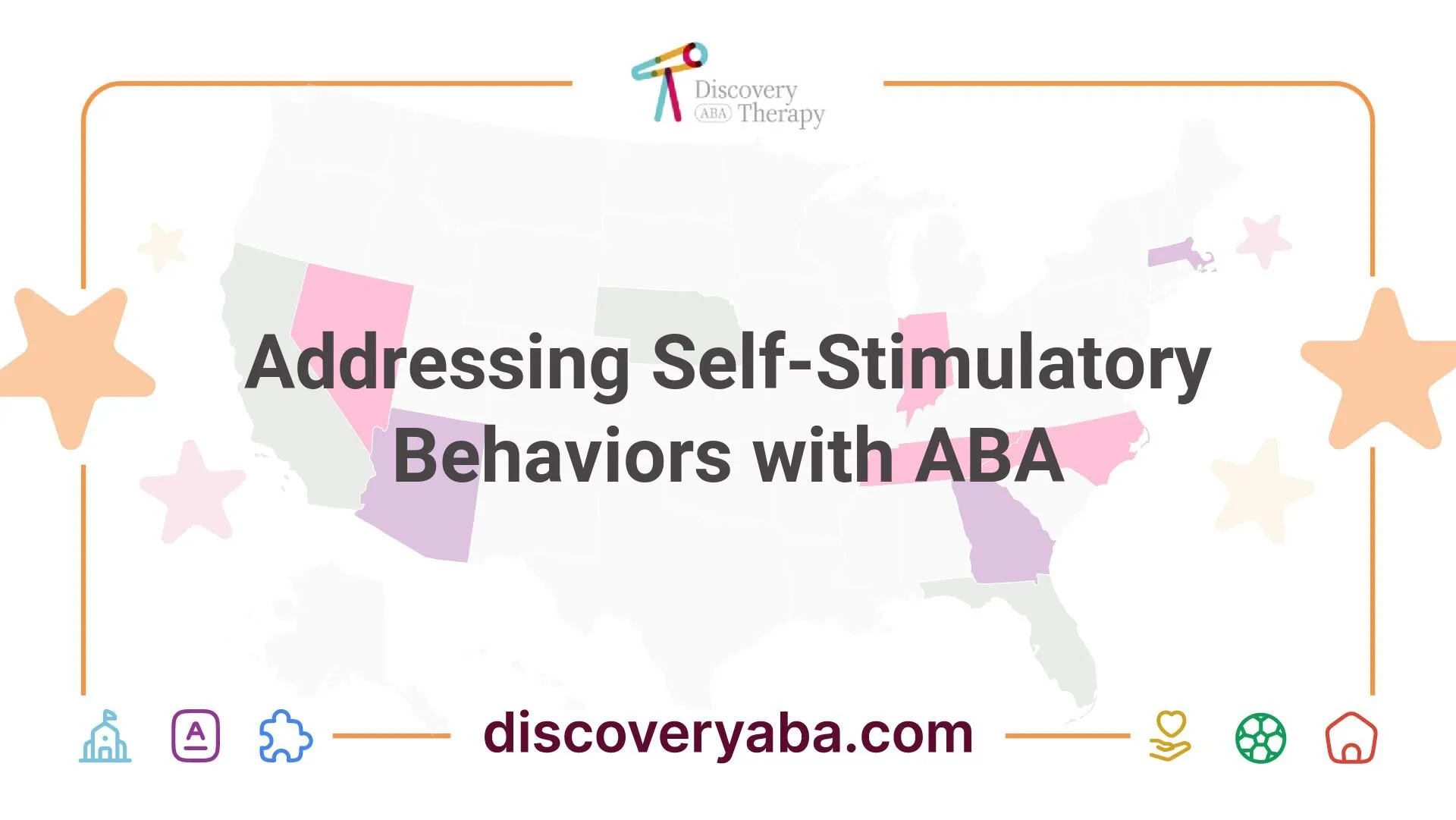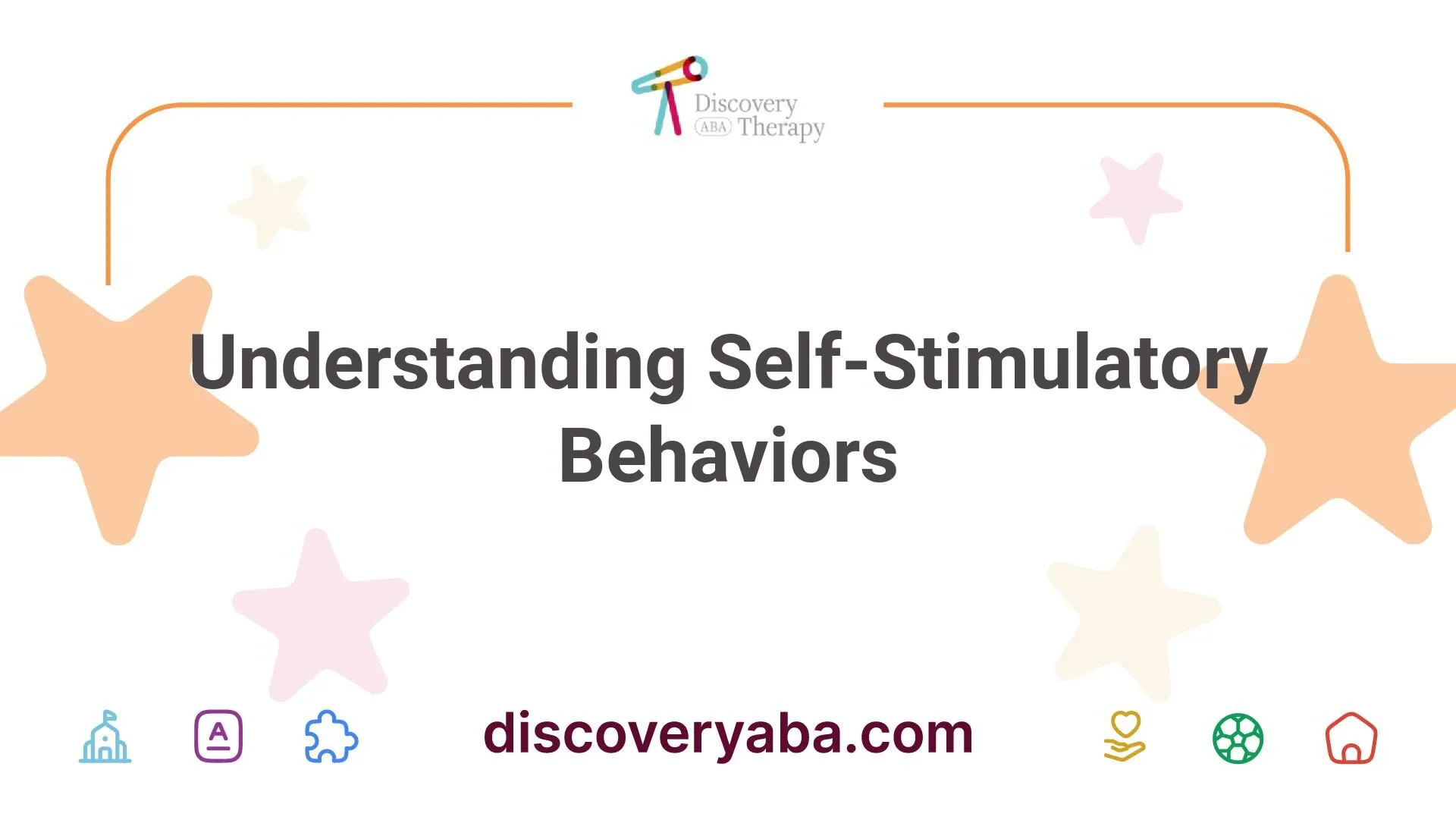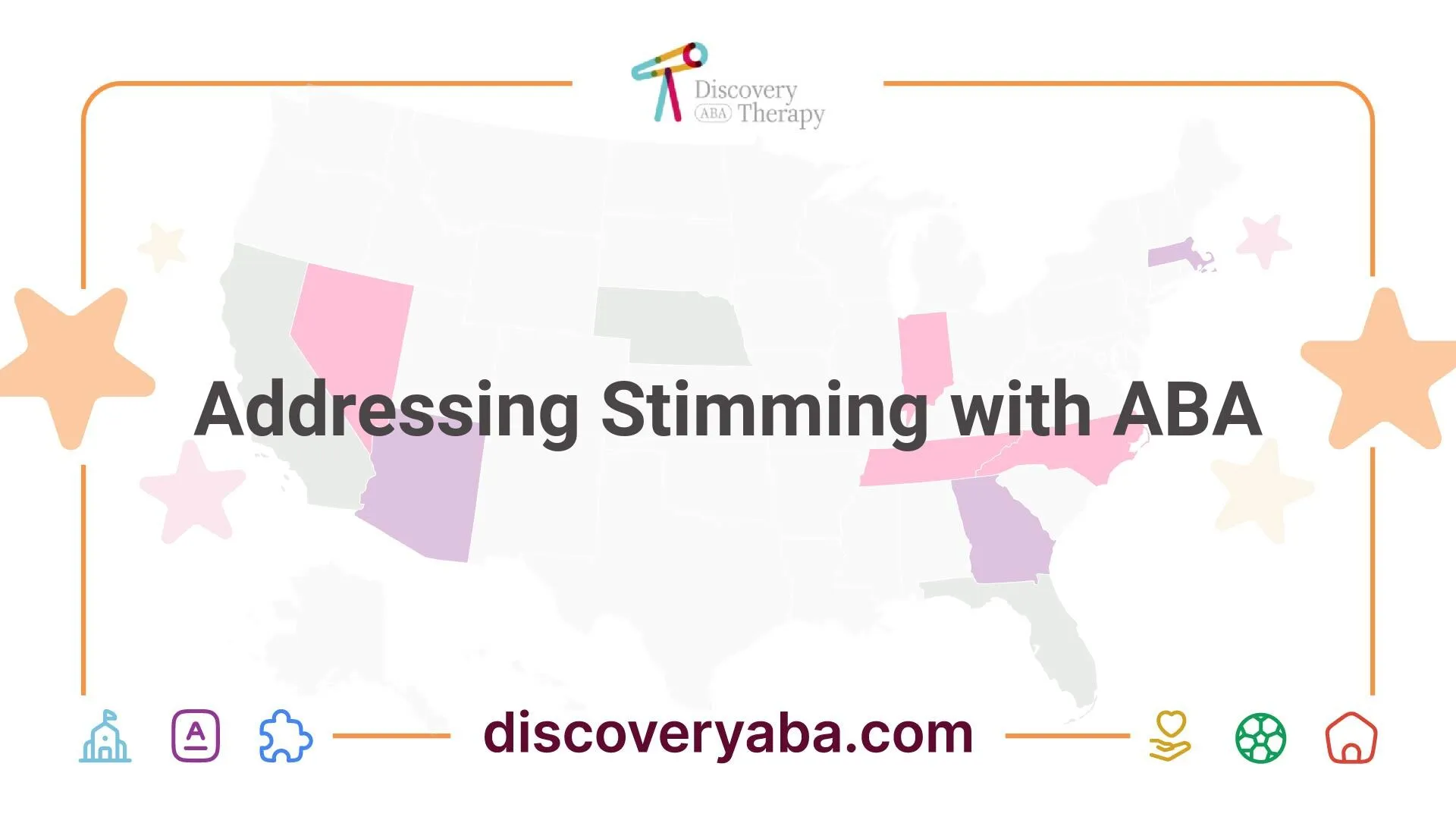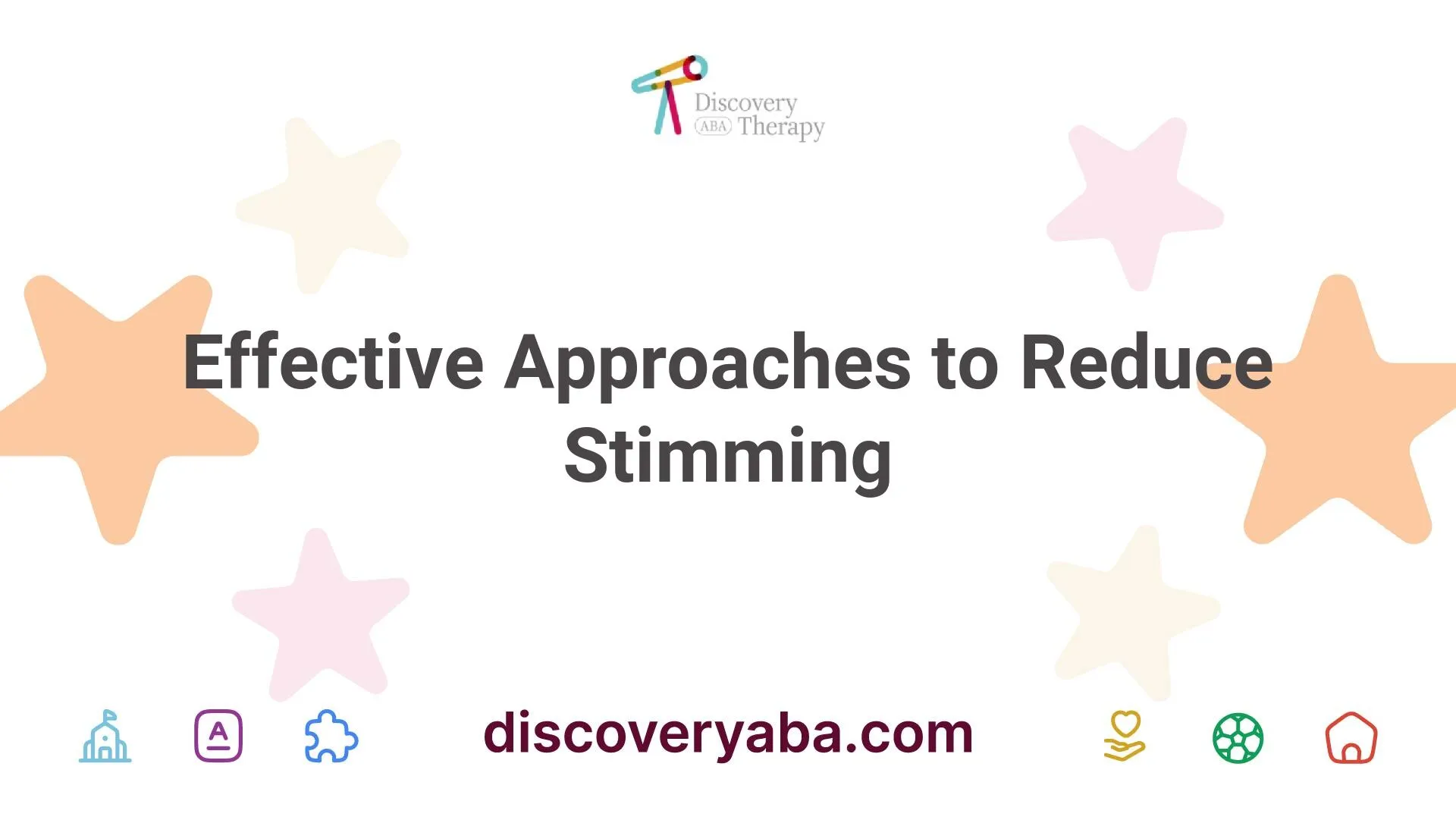Addressing Self-Stimulatory Behaviors with ABA
Explore strategies for addressing self-stimulatory behaviors with ABA to empower individuals with autism.


Understanding Self-Stimulatory Behaviors
Definition and Characteristics
Self-stimulatory behaviors, commonly referred to as stimming, are defined as repetitive, stereotyped actions that are functionally autonomous. These behaviors can be observed in both neurotypical individuals and those with developmental disabilities. Stimming is characterized by repetitive movements and/or vocalizations and is frequently associated with autism spectrum disorder (ASD) as well as other neurodevelopmental conditions [1].
Stimming can manifest in various forms, including but not limited to:
Type of StimmingExamplesMotor behaviorsHand flapping, rocking, spinningVocalizationsRepetitive sounds, humming, echolaliaVisual behaviorsGazing at lights or objects, flicking fingers in front of eyes
These behaviors are often a way for individuals to respond to their environment and can serve as a self-regulation mechanism.
Purpose of Stimming
Stimming serves several important functions for individuals, particularly in those with autism. Despite the challenges that may accompany these behaviors, they often play a critical role in emotional regulation. Stimming can help individuals manage their feelings, even if they do not actively recognize or articulate the need for such self-soothing techniques.
The triggers for stimming can include:
Understanding these underlying purposes is essential for caregivers and parents when addressing self-stimulatory behaviors with ABA. Through this awareness, better strategies can be developed to assist individuals in navigating their experiences and feelings effectively.

Factors Influencing Stimming
Understanding the factors influencing self-stimulatory behaviors, often referred to as "stimming," is essential for caregivers and parents of individuals with autism. These behaviors can serve various functions and may stem from different triggers.
Triggers and Functions
Stimming can result from a variety of emotional, sensory, and environmental triggers. Some common triggers include anxiety, excitement, or the need for sensory input. It often serves to help individuals self-regulate their emotions or manage overwhelming situations.
TriggerFunctionAnxietyCalming mechanismExcitementHeightening sensory experienceBoredomSelf-stimulation to alleviate boredomOverstimulationGrounding technique in overwhelming environments
Addressing these triggers can aid in managing stimming behaviors. Identifying the underlying reason for these actions is critical in tailoring effective strategies for each individual. Approaches such as teaching social cues with ABA or introducing routines can help decrease anxiety-related stimming.
Appearing Harmful
While many forms of stimming are benign, certain behaviors can appear harmful and may pose risks to the individual. Actions such as biting, pinching, or pressing on eyes can be detrimental and may detract from an individual's ability to concentrate or perform daily living skills.
When self-stimulatory behavior becomes harmful, professional intervention may be required to ensure the individual's safety. Effective approaches include behavior analysis and various strategies to help manage disruptive or dangerous stimming behaviors. Strategies for managing such behaviors can involve consulting with medical professionals to determine the root causes, reinforcing positive behaviors, and incorporating ABA therapy to guide a more constructive behavioral approach.
Awareness of the triggers and potential harm associated with stimming provides a foundation for caregivers to develop supportive strategies that ensure both safety and emotional well-being.

Acceptance and Management of Stimming
Understanding and embracing self-stimulatory behaviors, often referred to as stimming, can greatly benefit individuals on the autism spectrum. By shifting perspectives and employing professional intervention when necessary, parents and caregivers can develop more effective strategies for addressing self-stimulatory behaviors with ABA.
Shifting Perspectives
The narrative surrounding stimming behaviors is evolving. Traditionally viewed negatively, recent discussions highlight the positive functions that these behaviors can serve. Stimming helps individuals, both neurodiverse and neurotypical, manage their emotions, adapt to their environment, and self-soothe. In fact, a 2019 survey of Autistic adults revealed that 80% of participants reported stimming as a means to reduce anxiety and maintain calmness [3]. This shift suggests that instead of focusing on suppressing or eliminating stimming behaviors, it may be more beneficial to normalize them in certain social contexts and recognize their value in emotional regulation.
By promoting acceptance of stimming, caregivers can foster a safe environment where individuals feel comfortable expressing themselves. This perspective change can lead to improved mental well-being for those who engage in these behaviors, allowing them to flourish without undue pressure to conform to societal norms.
Professional Intervention
While it is essential to accept stimming behaviors, there are instances when such behaviors may become harmful or hazardous. In these cases, professional intervention is critical. When stimming poses risks to the individual or interferes with daily life, various strategies, including behavior analysis, can be implemented to manage these behaviors effectively [1].
Applied Behavior Analysis (ABA) offers several strategies for addressing harmful stimming behaviors while still emphasizing the importance of understanding the underlying reasons for these actions. It is crucial for caregivers to collaborate with professionals to develop individualized plans that acknowledge the positive aspects of stimming while also putting safeguards in place where the behaviors may become problematic.
Accepting and effectively managing self-stimulatory behaviors can empower individuals and enhance their quality of life. By leveraging the principles of ABA combined with a shifted mindset around stimming, parents and caregivers can provide meaningful support that respects the individual’s unique needs and experiences. For insights on how ABA can also be used for related issues, consider exploring strategies for teaching social cues with ABA or emotional recognition with ABA therapy.

Addressing Stimming with ABA
Applied Behavior Analysis (ABA) offers effective strategies for managing self-stimulatory behaviors, commonly referred to as stimming, in individuals with autism spectrum disorder. By understanding the principles of ABA, parents and caregivers can implement techniques that facilitate positive changes.
Applied Behavior Analysis (ABA)
ABA focuses on using evidence-based techniques to modify behavior. It is recognized as the gold standard for behavior therapy related to autism and is particularly effective in addressing stimming behaviors. Techniques such as behavioral interventions, environmental modifications, and even the use of therapeutic medications can help manage these behaviors effectively [3].
The application of ABA involves the following steps:
A goal of ABA is to enhance communication skills, cope with environmental stressors, and build adaptive skills which are essential for reducing stimming when it becomes disruptive.
Strategies for Behavior Shaping
Behavior shaping involves reinforcing positive behaviors while gradually eliminating or reducing stimming that interferes with daily functioning. Here are common strategies used within ABA to address stimming behaviors:
StrategyDescriptionPositive ReinforcementRewarding a child for engaging in alternative behaviors rather than stimming.Functional Communication TrainingTeaching the individual to express needs using appropriate words or gestures instead of resorting to stimming.Environmental ModificationsChanging aspects of the surrounding environment to reduce anxiety or sensory overload, which may trigger stimming.Gradual ExposureGradually introducing new experiences or social situations to help individuals cope without reverting to stimming.
Autistic individuals often report that stimming serves a positive emotional function, helping them manage anxiety and stay calm. In a 2019 survey, 80% of participants indicated that stimming helps them self-soothe.
Rather than eliminating stimming behaviors entirely, ABA focuses on accepting and managing them when they serve a beneficial purpose, while minimizing those that might lead to negative outcomes. For further support in addressing self-stimulatory behaviors, parents may also explore teaching social cues with ABA and other linked strategies.

Effective Approaches to Reduce Stimming
Addressing self-stimulatory behaviors with ABA involves implementing effective strategies that can significantly improve the quality of life for individuals with autism. Two key approaches are identifying triggers and teaching adaptive skills.
Identifying Triggers
Understanding the specific triggers that lead to stimming can help caregivers implement proactive strategies to minimize these behaviors. Observing and documenting the situations in which stimming occurs can provide insights into the underlying causes.
Providing opportunities for sensory input throughout the day—such as exercise, including jumping on a trampoline, walking, running, or carrying heavy objects—can reduce self-stimulatory behaviors in some individuals on the autism spectrum. Engaging in these activities can offer beneficial sensory stimulation that fulfills the needs often met by stimming [4].
Trigger TypeExample SituationsSensory OverloadNoisy environments, bright lightsAnxiety-Inducing ScenariosSocial interactions, unfamiliar settingsBoredomLack of engagement in activities
Successfully reducing self-stimulatory behaviors can lead to improved life quality, allowing individuals to learn without distractions and interact freely without fear of exclusion [5].
Teaching Adaptive Skills
Teaching adaptive skills involves helping individuals replace self-stimulatory behaviors with more appropriate alternatives. This can include identifying and developing functional skills that serve similar purposes but are socially acceptable and non-disruptive.
Some strategies include reinforcing positive behaviors and reimagining stimming in situations where it may be disruptive. Increasing physical activity and initiating Applied Behavior Analysis (ABA) therapy can significantly improve the individual's ability to manage their stimming behaviors effectively.
Additional strategies for managing stimming behaviors include:
Each of these approaches aims to empower individuals with autism to express themselves in a healthier, more productive manner, fostering a sense of independence and social integration. For more insights on specific ABA techniques, check out our articles on teaching social cues with aba and aba for co-occurring mental health disorders.

Personalized Programs for Stimming
Personalized programs are essential in addressing self-stimulatory behaviors with ABA. Tailoring interventions to meet individual needs can lead to more effective management and improvement in daily functioning.
Individualized ABA Therapy
Individualized ABA therapy focuses on creating customized treatment plans that consider the unique characteristics of the individual. This approach allows for targeted interventions that address specific stimming behaviors, while also promoting adaptive skills. Such personalization helps ensure that the strategies used resonate with the individual’s preferences and situations.
The development of an individualized program often begins with a thorough assessment, which includes analyzing the circumstances surrounding the self-stimulatory behaviors and determining their functions. By understanding these factors, professionals can craft strategies that are more likely to yield positive results.
In a 2019 survey of autistic adults, 80% reported that stimming helped reduce anxiety and maintain calmness. These insights guide therapy, emphasizing acceptance and understanding of stimming as a potential coping mechanism unless it negatively impacts the individual’s quality of life [3].
Positive Intervention Strategies
Implementing positive intervention strategies is integral to managing stimming behaviors effectively. These strategies focus on reinforcing appropriate, alternative behaviors while respecting the need for self-soothing actions. Positive approaches may include:
Behavior therapy is considered the gold standard for managing self-stimulatory behaviors. This method applies principles of behaviorism to reshape compulsive actions while offering support through qualified mental health professionals. This structured approach not only aims to reduce the frequency of stimming but also reinforces the individual’s overall emotional resilience.
Further strategies may involve engaging in cognitive-behavioral techniques to help individuals reframe their thoughts around stimming. Such reformulation can foster a greater sense of control and alleviate the anxiety associated with these behaviors.
In summary, personalized ABA programs can significantly enhance the well-being of individuals with autism, allowing them to navigate their world more effectively while embracing strategies that support their unique needs. Parents and caregivers are encouraged to collaborate with qualified therapists to design and implement these programs tailored specifically to their loved ones.
References
[2]:
[3]:
[4]:
[5]:
Does Your Child Have An Autism Diagnosis?
Learn More About How ABA Therapy Can Help
Find More Articles
Contact us
North Carolina, Nevada, Utah, Virginia
New Hampshire, Maine
Arizona, Colorado, Georgia, New Mexico, Oklahoma, Texas
.avif)




































































































